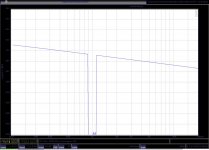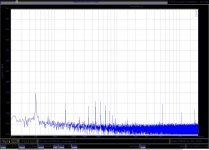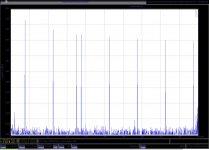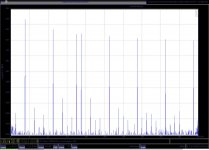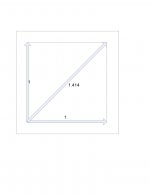Vlad, you have done some interesting work. This sort of noise test was first used extensively by the BBC in the 1970's. As it is somewhat difficult to put a NUMBER on it, people tend to ignore it, BUT it appeared then, and may still be now, a wonderful way to test audio products. R.A. Belcher should be your reference here.
Attachments
I can see their benefit is coupling caps in tight designs ....and other critical places.
Ah, so the 10X cost is not a problem (?)
(DALI I presume?)
Weird is the one who pulls the bottom drawer.
On the measurement using pulsed tones, in the ”for what it’s worth’ category, consider that the language independent measurement that can predict speech intelligibility (called STIpa) uses an audio version of a modulation transfer function measurement using a speech weighted voice spectrum (7 bands are used if I recall).
While this is intended for use in commercial sound were being able to understand a voice is now a legal requirement in some places, it has an interesting parallel in audio as what it measures is how much of the signal going in, reaches the measurement location.
The original use for the MTF measurement was optics, as a measure of resolution and you can get an idea what it does from that;
Modulation Transfer Function - what is it and why does it matter? - photo.net
The measurement platform ARTA has a routine for taking the audio version of the MTF.
Here one has a base tone which is amplitude modulated at increasing rates. If the device can preserve the original level of modulation, then one has a flat line with increasing modulation rates, if not, it droops off as the rate increases.
This can be done at a number of different frequencies.
With loudspeakers generally having so many more flaws than electronics, there are huge differences in loudspeakers, rarely will a loudspeaker pass three generations in a generation loss recording and still be listenable yet there is rough correlation to better MTF’s = more generations = more faithful reproduction.
Loudspeakers scatter time information in a dynamic signal and this very much harms the MTF for example.
In audio a real problem is tying a feature in a measurement to something one hears and vis versa. I have found both the generation loss recordings useful because they turn a minor flaw into a glowing red flag and sometimes making it easier to identify. While the MTF measurements are not a number but a set of curves to compare, these may be useful here where what you want is to preserve dynamic information unaltered and very few measurements are under dynamic conditions.
Best
Tom Danley
Danley Sound Labs
While this is intended for use in commercial sound were being able to understand a voice is now a legal requirement in some places, it has an interesting parallel in audio as what it measures is how much of the signal going in, reaches the measurement location.
The original use for the MTF measurement was optics, as a measure of resolution and you can get an idea what it does from that;
Modulation Transfer Function - what is it and why does it matter? - photo.net
The measurement platform ARTA has a routine for taking the audio version of the MTF.
Here one has a base tone which is amplitude modulated at increasing rates. If the device can preserve the original level of modulation, then one has a flat line with increasing modulation rates, if not, it droops off as the rate increases.
This can be done at a number of different frequencies.
With loudspeakers generally having so many more flaws than electronics, there are huge differences in loudspeakers, rarely will a loudspeaker pass three generations in a generation loss recording and still be listenable yet there is rough correlation to better MTF’s = more generations = more faithful reproduction.
Loudspeakers scatter time information in a dynamic signal and this very much harms the MTF for example.
In audio a real problem is tying a feature in a measurement to something one hears and vis versa. I have found both the generation loss recordings useful because they turn a minor flaw into a glowing red flag and sometimes making it easier to identify. While the MTF measurements are not a number but a set of curves to compare, these may be useful here where what you want is to preserve dynamic information unaltered and very few measurements are under dynamic conditions.
Best
Tom Danley
Danley Sound Labs
Ah, so the 10X cost is not a problem (?)
It depends on the design, but 5 or 6 for coupling is different to hundreds used for decoupling...and on some designs size is critical.
Thanks, John, Tom Danley. Who wants to see, he could see. As always, more valid is more difficult, simple models are more convenient. The transfer function is not rock solid, it "vibrates" during settling process, and non-stationary signal (music) is a continuos chain of transients.
Last edited:
You can do this measurement nowadays very simple, using e.g. ARTA, multitone signal, high decade. 13 tones from 2kHz to 20kHz. And observing band from 0 to 2kHz for IMD products.
But you will not find any special "X" distortion with noise or multitone signals, which are not easy detectable with ordinary measurements.
It would indicate better what the total level of the distortion byproducts are which would be listened to along with the music.
As a single number (%), it better indicates whether or not the total distortion level is reaching an audible threshold ---> a single tone vs multitone's total distortion. Multitone and maybe noise source gets us closer measure to what is relevant for audio.
THx-RNMarsh
Last edited:
just doing these test in your soundcard in loopback usually shows that the often indifferent op amps, series Cap by audiophile standards give no surprises, IMD in line with the expectation of the Harmonic distortion of the sys
as mentioned the BBC researchers found the "noise fill" test useful on speakers, and their listening correlation with listening test went away at better than ~ -35 dB "noise fill" numbers
we need a radically new theory of human aural perception to say -100 dB numbers in electronics are audible
any psychoacoustic researcher needing to pad his resume for tenure would love to publish something "different" - that holds up in peer review
as mentioned the BBC researchers found the "noise fill" test useful on speakers, and their listening correlation with listening test went away at better than ~ -35 dB "noise fill" numbers
we need a radically new theory of human aural perception to say -100 dB numbers in electronics are audible
any psychoacoustic researcher needing to pad his resume for tenure would love to publish something "different" - that holds up in peer review
Last edited:
we need a radically new theory of human aural perception to say -100 dB numbers in electronics are audible
any psychoacoustic researcher needing to pad his resume for tenure would love to publish something "different" - that holds up in peer review
IMO, I thought -100dB is probably Not audible... which is the point of making gear to =/< -100db THD. I use the Quad ESL for their very low distortion and with that and the ability to add in measured amounts of distortion to music, one learns his/her limits on what is just detectable level. Then, we make the gear at least 10X lower than that level. That is where the -100dB comes from.
But, as I said here last year, it is the entire record/reproduce system which we are hearing/listening to. So, tests also need to be done from source to power amp outlet... thru the entire system we are hearing/listening to. That is another reason to be at or below -100dB for each piece of gear in the series of components.... so the complete system is transparent. If the entire system - from recording mic preamp to home amp speaker terminals were measured to be -100dB it would be transparent and truely "blameless". We are getting closer but we are not there now.
______________
I just had an interesting experience to relate on this forum --- I had a power amp that had low THD. I changed the Re of the output transistors from .22 down to 0.1 Ohm, and re-biased(increased) the OPStage to achieve lowest THD numbers at 10-40W output (8 Ohm load). I achieved a null in THD with bias in the range of 60-80mA/ Then I listened.... the sound became a LOT more detailed and reveling of details like I never heard before with this familiar amp. And what is the new lower THD level at typical average power output? -100dB (1KHz) !!
THx-RNMarsh
Last edited:
I call that weird.
(DALI is presume?)
Yep, one of Dali's "masterpieces" depending on your point of view.
or just a pun, "chest" of drawers?
I use the Belcher test all the time. Also notched noise and TIM square.
Problem is that it does not reveil anything new in linear electronics that a conventional measurement does not show.
For codec´s and speakers it is very usefull though.
Here you can see some shots i made from the bespoke AD797 intrumentation stage i mentioned. There is some life under -120dB but if that is audible i do not know.
The first picture is the noise notch, then the Belcher test and then the TIM square method.
The last picture shows an open loop JFet phono input. Here you can see some distortion and also a lower noisefloor then the AD797 ( paralleled ) stage can manage.
Problem is that it does not reveil anything new in linear electronics that a conventional measurement does not show.
For codec´s and speakers it is very usefull though.
Here you can see some shots i made from the bespoke AD797 intrumentation stage i mentioned. There is some life under -120dB but if that is audible i do not know.
The first picture is the noise notch, then the Belcher test and then the TIM square method.
The last picture shows an open loop JFet phono input. Here you can see some distortion and also a lower noisefloor then the AD797 ( paralleled ) stage can manage.
Attachments
Last edited:
The original use for the MTF measurement was optics, as a measure of resolution and you can get an idea what it does from that;
The measurement platform ARTA has a routine for taking the audio version of the MTF.
Here one has a base tone which is amplitude modulated at increasing rates. If the device can preserve the original level of modulation, then one has a flat line with increasing modulation rates, if not, it droops off as the rate increases.
Tom with all due respect I find the two uses of the word modulation here to have vastly different meanings. The optical MTF is the magnitude of the impulse response of the optical system, a stationary property. I don't follow the analogy to amplitude modulation of a base tone.
Richard,
I think what you are alluding to here with the <100db noise level of each stage in the chain is that in the end the resultant is not the sum of the noises but the product of the noise of each stage. It isn't a linear addition, it is a multiplication of noise from one stage to the next.
I think what you are alluding to here with the <100db noise level of each stage in the chain is that in the end the resultant is not the sum of the noises but the product of the noise of each stage. It isn't a linear addition, it is a multiplication of noise from one stage to the next.
Richard,
I think what you are alluding to here with the <100db noise level of each stage in the chain is that in the end the resultant is not the sum of the noises but the product of the noise of each stage. It isn't a linear addition, it is a multiplication of noise from one stage to the next.
-- you (me) have to use worst case possible combination to be assured no one can hear the distortion thru any system of components. .
-RM
IMO, I thought -100dB is probably Not audible... which is the point of making gear to =/< -100db THD. I use the new Quad ESL for their very low distortion and with that and the ability to add in measured amounts of distortion to music, one learns his/her limits on what is just detectable level. Then, we make the gear at least 10X lower than that level. That is where the -100dB comes from.
But, as I said here last year, it is the entire record/reproduce system which we are hearing/listening to. So, tests also need to be done from source to power amp outlet... thru the entire system we are hearing/listening to. That is another reason to be at or below -100dB for each piece of gear in the series of components.... so the complete system is transparent. If the entire system - from recording mic preamp to home amp speaker terminals were measured to be -100dB it would be transparent and truely "blameless". We are getting closer but we are not there now.
______________
I just had an interesting experience to relate on this forum --- I had a power amp that had low THD. I changed the Re of the output transistors from .22 down to 0.1 Ohm, and re-biased(increased) the OPStage to achieve lowest THD numbers at 10-40W output (8 Ohm load). I achieved a null in THD with bias in the range of 60-80mA/ Then I listened.... the sound became a LOT more detailed and reveling of details like I never heard before with this familiar amp. And what is the new lower THD level at typical average power output? -100dB (1KHz) !!Now I have to re-evaluate my thinking on the lower limit of audibility as it relates to a single tone THD test number. And, I have to do a multi-tone and see what the total THD is and correlate the single tone vs multi tone numbers for audibility threshold.
THx-RNMarsh
Last edited:
I have to put my math hat on some times and think these things through. I understand practically about the non correlation factor but not sure how that would work mathematically.
It's fairly simple: power, not voltage.
Got it Sy,
I have to put my math hat on some times and think these things through. I understand practically about the non correlation factor but not sure how that would work mathematically.
Thanks, Steven
One plus one no longer equals 2.
jn
Attachments
- Status
- Not open for further replies.
- Home
- Member Areas
- The Lounge
- John Curl's Blowtorch preamplifier part II
